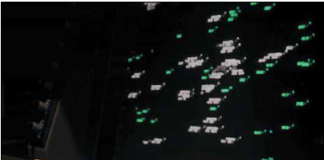When planning an approach to minimums there are many items to check, like the missed approach point. But sometimes, there can be more than one MAP … if you’ve briefed accordingly.
RNAV or LOC?
There’s one runway and three approaches at Rutherford County-Marchman Field in Rutherfordton, North Carolina: LOC 1, RNAV 1, and RNAV 19. Northeast winds prevail today, so we’ll use Runway 1. The undulating cloud bases in the 400-600 foot range will be a workout with dual CDIs and non-WAAS GPS. The two MDAs and visibility minimums are nearly identical: 1420-1 for the RNAV (using LNAV only) and 1440-1 for the localizer (with dual VORs).
The finals for both approaches also are similar, including the intersections EPOZI (IF/IAF) and JAKIB (FAF). Altitudes are both 3000 to EPOZI, then 2700 to JAKIB. From there, they vary a bit, with 1600 for the LOC ’til DASCA (2.7 DME) followed by the MDA. The LNAV-only is 1700 feet after JAKIB to CUVUG (1.9 NM to the runway), then the straight-in MDA. In the event of a missed approach, both procedures climb to the left to go to EPOZI for a hold.
For the LOC 1, the MAP at I-FQD is 0.9 NM DME to the runway threshold. Meanwhile, the RNAV 1 allows descent to 1420 feet after CUVUG and for LNAV only, misses at the runway 1.9 NM later.
Yet another similarity in the briefing boxes includes use of a non-local altimeter setting: If that’s the case, MDAs for both approaches will go up 80 feet, and “VDP NA.” The local weather station’s working as far as you know, and you do want that visual descent point, right? Um, maybe. How’s that gonna work?
Keep Briefing
As discussed in the AIM, VDPs allow descent from the MDA “provided the approach threshold of that runway, or approach lights, or other markings identifiable with the approach end of that runway are clearly visible to the pilot.” The VDP is also a hint that the 20:1 slope to the runway is clear of obstacles; otherwise there wouldn’t be a VDP. The AIM goes on to caution: “On a straight-in nonprecision IAP, descent below the MDA between the VDP and the MAP may be inadvisable or impossible. Aircraft speed, height above the runway, descent rate … are some of the factors which must be considered by the pilot to determine if a safe descent and landing can be accomplished.”
We’ll assume that the approach designers made it realistic to reach the VDP at minimums. Then, the AIM says we can land from the VDP, but let’s go through the math to be sure.
The RNAV VDP is 1 NM from the runway and there’s 361 feet from the LNAV mins to the TDZ. That’s 3.4 degrees and at 100 knots requires about 600 fpm. That’s a tad steep but not unrealistic. On the LOC, it’s 1.1 NM and 381 feet. That works out to 3.3 degrees and 575 feet per minute—a bit easier.
So, all this shows that you can reach the VDP, and from there—assuming you can see something required by 91.175—reach the runway, all with workable descents. But, what if the weather is at minimums? That might be a different story.
First, there’s a trap here that catches many pilots. Do you see it? Yup, visibility and minimums are reported in statute miles, but the chart plots nautical miles. With visibility at the 1-SM minimum, you won’t see the runway from either VDP; it’s too far. But, can you land once you do see something usable?
Assume you’re exactly 1 SM from the runway when you see something from 91.175. On the LOC you’re at 1440 feet and at 1420 on the RNAV. The LOC is the worst case. That 381-foot descent on the LOC from 1 SM out is 4.1 degrees requiring 730 fpm at 100 knots groundspeed. That’s steep, but the PIC must decide if it’s within 91.175’s “normal rate of descent using normal maneuvers,” which isn’t officially defined.
Big Picture
Note that while there are REIL and MIRL for Runway 1, there’s no approach lights or glidepath indicator. Hopefully you caught that early so you’re not looking for approach lights. Perhaps you will spot the REILs first, but it’d be nice to have a bright approach lighting system shining through the muck to get in sight earlier—even from the VDP or before—so you can start down (once you confirm you have the required visibility using cues from those lights).
With the visibility right at minimums, you’re not going to see anything useful from the VDP. If you continue along at MDA past the VDP, it’s on the edge and you might be tempted to try it.
If you’d used the VDP as the MAP, it would have stopped any temptation to dip below MDA or make a steep descent. Or if you do have a clean breakout at the VDP, you have a comfortable distance in which to transition to visual conditions while descending. Some pros use this method to make at-minimums approaches safer while accounting for their greater speeds and landing distances. All sizes of aircraft can certainly use this tool and work it into an approach briefing. If prepped to do so, using VDPs can make that short final safer, whether it’s to a missed or a full stop landing.




